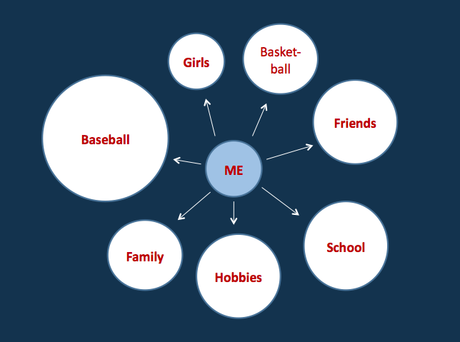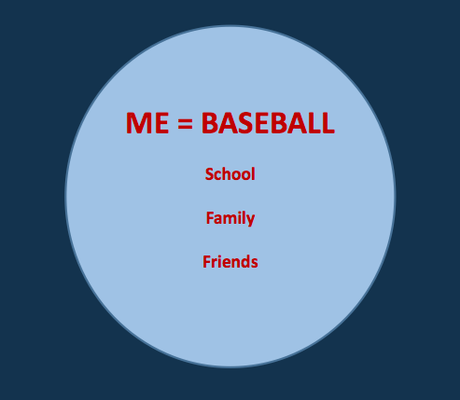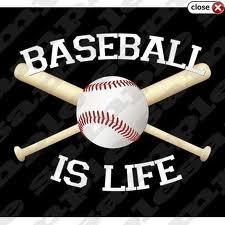For many young kids who play the game from an early age, their lives look like the following graphic. We’ll call this kid Player A.

Player A
Even though setbacks occur for them in the game (0 for 4, 3k’s, 2 errors, .240 batting average, cut from the team, etc.) other parts of their life help to make up for any difficulties. Although baseball may be very important to them, it doesn’t define who they are as a person. Basically, the game of baseball doesn’t become their identity. Baseball is just one of many things going on in the kid’s life. Should this type of player get cut from a team, they have other things to fall back on to quickly fill the void. Family outings, friends not connected to baseball, other sports, other school activities, and other hobbies all can help a player move on. Even though they face the same adversity in the game as others do, these kids tend to get over it pretty quickly.
For other players – we’ll call this kid Player B – their life looks more like this …

Player B
Baseball and life are one. There are no separate parts to their life. Everything they do is flavored in baseball. Their passion for the game is second to none. They are the first on the field and the last to leave. They play tons of games and are always looking for ways to improve. They eat, sleep, and breathe baseball. They tend to be the best players and the players we as coaches love.
But parents and coaches beware. There is a negative side to this type of kid.
When things go bad, things get REALLY bad for this type of player. This is because baseball has become his identity. His only hobby is baseball. His only friends are his baseball teammates. His family outings are “vacations” to tournaments and showcases. His only school activity is baseball. His downtime entertainment is watching or learning more baseball. When things start to go bad for him, his whole life spirals downward. At least until he has another good game. In short, his entire self-worth and self-esteem depends on how he plays.
When Player A fails on a bunt attempt he may say “My bunt failed.” When Player B fails on a bunt attempt, he’s more likely to think “I am a failure.” Player A’s failures are situational and temporary. Player B’s failures are personal and persistent. Player B often has major mood swings that coincide with good and bad games. That is because it isn’t just his performance that goes up and down. In his mind, it’s he as a person that fluctuates. If his success as a person is connected to his performance on the field, you can see why he takes the game so seriously. If he doesn’t succeed in the game, what else does he

No, it’s not.
have?
The pressure these kids put on themselves is obviously enormous which usually leads to high levels of anxiety. Anxiety and baseball don’t tend to be a good mix. This extreme anxiety caused by so much riding on every at-bat, pitch, or win can sap the fun out of the game rather quickly. For some, quitting isn’t an option because they and their parents have invested so much time, energy, and money in their development. They don’t want to let anyone down and therefore feel stuck with no way out. For others, quitting the game (to the surprise of everyone) is the only option to escape the emotional rollercoaster they put themselves through.
There is a fine line between passion and obsession. Passion is not only good, it is needed if you want to keep playing the game at a higher level. Obsession, however, needs to be identified and addressed if the player wants to keep playing.
For parents and coaches, it can be a difficult problem to deal with. Sometimes a player will start out with a genuine passion. Coaches and parents see this as a positive thing and naturally support that passion. In the mind of the player, if this eventually turns into an obsession, the coaching and parental support may appear to the player as additional pressure that starts to be resented.
If this sounds familiar, an upcoming post will include some tips for players, coaches, and parents who would like to identify all this sooner and deal with it in a positive way.

